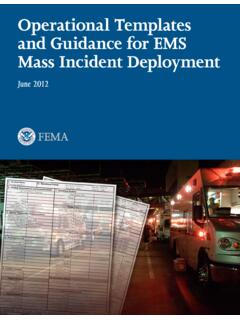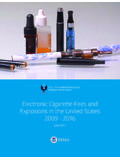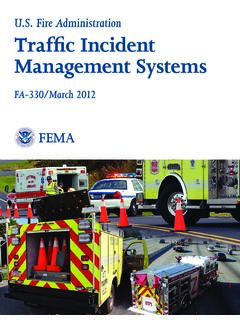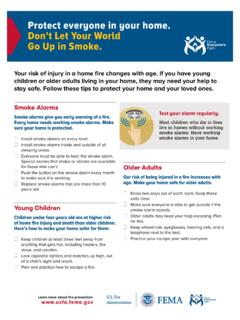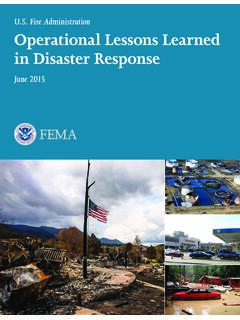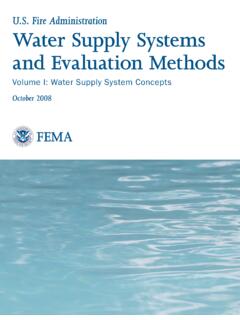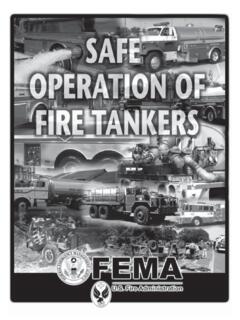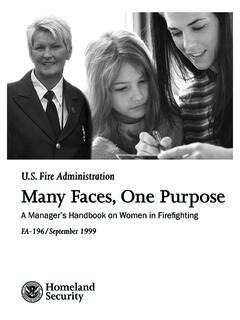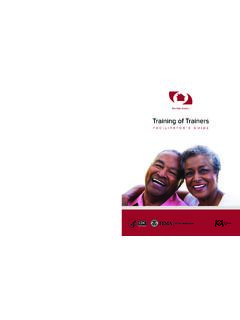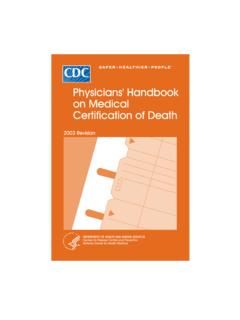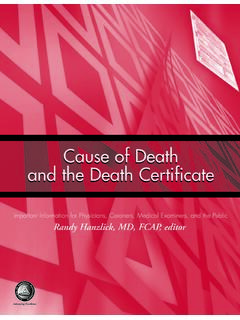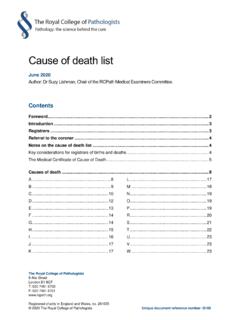Transcription of Emergency Vehicle Safety Initiative - U.S. Fire Administration
1 fire AdministrationEmergency Vehicle Safety InitiativeFA-336/February fire AdministrationMission StatementWe provide national leadership to foster a solid foundation for our fi re and Emergency services stakeholders in prevention, preparedness, and response. iTable of ContentsTable of Contents ..iPreface ..viiChapter 1 Introduction ..1 Early Efforts to Address This Issue ..1 Safe Operation of Tankers ..2 Emergency Vehicle Safety Initiative ..2 Multiple fire Service Association Projects ..3 Additional Research on Vehicle and Roadway Safety ..5 Traffic Incident Management Systems.
2 5 Technology and Incident Reporting Research ..5 Emergency Vehicle Visibility and Lighting Research ..6 Other Government Initiatives for Roadway Safety ..7 National Traffic Incident Management Coalition ..7 Federal Highway Administration Traffic Incident Management Website ..8 Federal Highway Administration Traffic Incident Management Handbook ..8 Manual on Uniform Traffic Control Devices ..8 About This Report ..11 Chapter 2 Statistics and Case Studies ..13 Introduction ..13 Limitations ..13 fire Department Statistics ..13 Injuries Responding To and From an Alarm.
3 13 Cause and Location of Incidents Resulting in Injuries ..13 Firefighter Fatalities ..16 Law Enforcement Statistics ..17 Injuries and Cause ..17 Fatalities ..18 Emergency Medical Services Statistics ..19 Injuries ..20 Fatalities ..20 Case Studies ..21 Firefighter Fatalities ..21 Law Enforcement Officer Fatalities ..26 Chapter 3 Common Crash Causes and Their Prevention ..33 Intersections ..33 Emergency Vehicle Safety Initiative ii Excessive Speed ..35 Keeping the Vehicle s Wheels on the Road Surface ..37 Safely Negotiating Curves ..38 Passing Other Vehicles Safely.
4 39 Vehicle Unfamiliarity ..40 Driving in Inclement Weather ..42 Avoiding and Combating Skids ..44 Safe Vehicle Spacing ..45 Vehicle Backing Operations ..46 Driver Distractions ..47 Siren Syndrome ..48 Fatigue ..48 Seatbelt Usage ..49 Summary ..50 Chapter 4 The Impact of Vehicle Design and Maintenance on Safety ..53 Introduction ..53Ve h ic le D e s ig n ..53 fire Apparatus ..53 Law Enforcement Vehicles ..53 Ambulances ..54 Restraints ..55 Loose Equipment Storage ..56 Emergency Vehicle Lighting ..58 Warning Light Colors ..58 Red Lights .. 58 Amber Lights.
5 59 Green of Warning Lights ..60 Rotating Flashing Lights ..61 Light-emitting Diode Lighting ..61 Other Types of Warning Lights ..62 Available Research on Emergency Vehicle Lighting ..63 iiiPhoenix fire Department Study ..63 Loughborough University Study ..63 Flash Rate ..64 Light Color ..64 Hazards to Motorists ..64 Arizona Blue Ribbon Panel Study and Report ..65 Light Output ..65 Light Color ..65 Flash Rates ..65 Ramp Highway Patrol Study ..66 Light Color ..66 Flash Rate and Pattern ..66U .S . fire Administration /Federal Emergency Management Agency Sponsored Research.
6 66 Conspicuity ..70 Retroreflectivity ..70 Factors Affecting Visibility and Recognition ..70 Contrast ..71 Fluorescent Colors ..71 Research Findings Related to Conspicuity ..71 Contour Markings ..71 Placement ..71 Fluorescent Colors ..72 Efficiency ..72 Standards Related to Emergency Vehicle Visibility and Conspicuity ..72 fire Standards ..72 Law Enforcement Standards ..73 Emergency Medical Services Ambulance Standards ..73 Vehicle Inspection and Maintenance ..74 Routine Inspection and Maintenance ..74 Removing a Vehicle From Service ..74 Summary ..75 References.
7 75 Chapter 5 Improving Response-related Safety : Internal Factors ..77 Introduction ..77 Agency Vehicle Response Policies ..77 Standard Operating Procedures ..77 Prioritizing Dispatch ..77 Response Matrix ..78 Alternative Response Policies for fire Departments ..78 Alternative Response Policies for Emergency Medical Services ..80 Alternative Response Policies for Law Enforcement Agencies ..80 iv Emergency Vehicle Safety InitiativeTraining ..82 Training Requirements ..82 Identifying the Need for Additional Training ..84 Training Program Components ..85 Available Training Programs and Resources.
8 86 Emergency Vehicle Occupant Safety ..86 Responsibilities of the Driver ..86 Safety Usage in fire of the Company/Lead Officer ..87 Responsibilities of the Passenger ..88 Department/Agency Responsibilities ..89 Personal Responsibilities ..90 Summary ..91 Chapter 6 Improving Response-related Safety : External Factors ..93 Introduction ..93 DOT Intelligent Transportation Systems Program ..93 Traffic Surveillance Technology ..94 Mayday and Automatic Collision Notification Systems ..94 Intelligent Vehicles ..95 Freeway Service Patrols ..95 Next Generation 9-1-1.
9 95 Dynamic (Changeable) Message Signs ..97 Traffic Signal Pre-emption Systems ..98 Implementation ..98 Vehicular Device Types ..99 Acoustic ..99 Line-of-sight ..99 Global Positioning System ..100 Localized Radio Signal ..100 Traffic Management Centers ..101 Closed Circuit Television Camera Surveillance ..101 Roadway Weather Information Lane Message Signs ..101 Safe Operation of Privately Owned ..104 Chapter 7 Regulating Emergency Vehicle Response and Roadway Scene Safety . 105 Introduction ..105 National fire Protection Association Standards ..105 NFPA 1002, Standard for fire Apparatus Driver/Operator Professional vNFPA 1091, Standard for Traffic Control Incident Management Professional Qualifications.
10 106 NFPA 1451, Standard for a fire and Emergency Services Vehicle Operations Training Program ..107 NFPA 1500, Standard on fire Department Occupational Safety and Health Program ..109 NFPA 1917, Standard for Automotive Ambulances ..112 DOT Manual on Uniform Traffic Control Devices ..112 Temporary Traffic Control Zones ..112 Advanced Warning n sition A Area ..114 Channelizing Devices ..114 Signs ..116 Directional Arrow Boards ..117 Barricades ..119 Flagger Control ..120 Hand-signaling Location ..121 Audible Warning Visibility Safety Apparel ..122 American National Standards Institute/International Safety Equipment Association National Standards Institute/International Safety Equipment Association.
